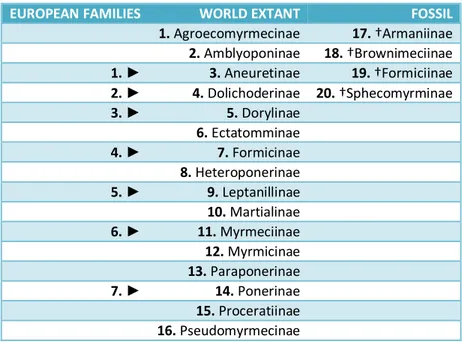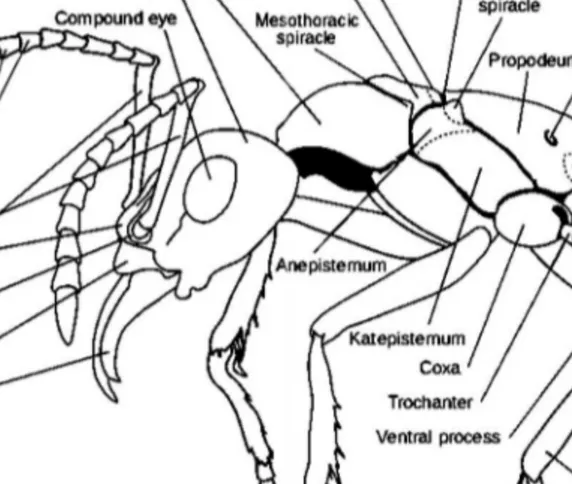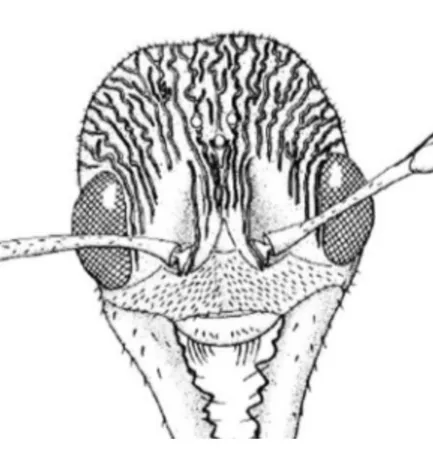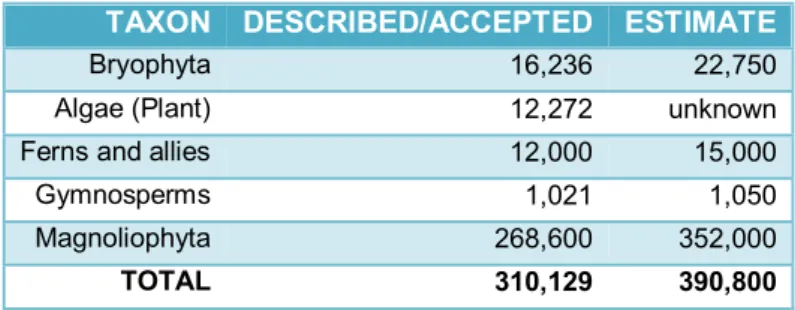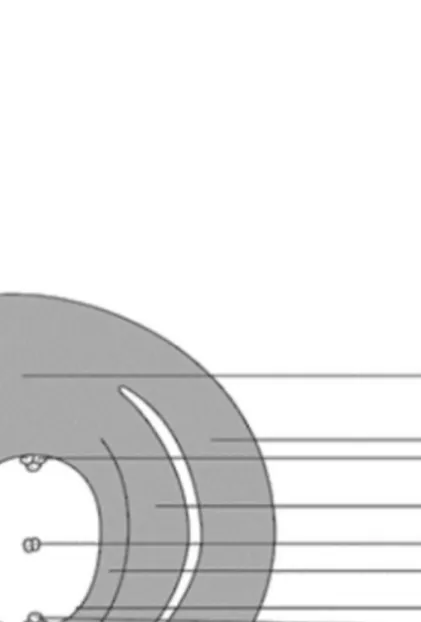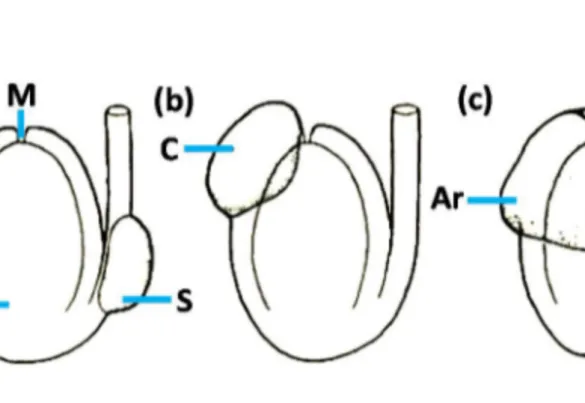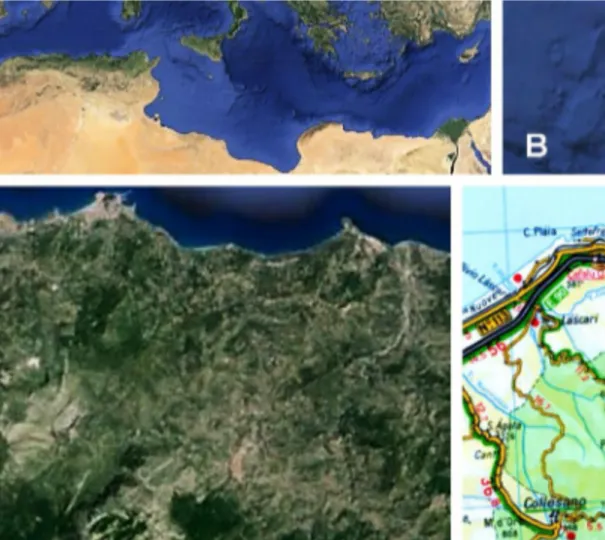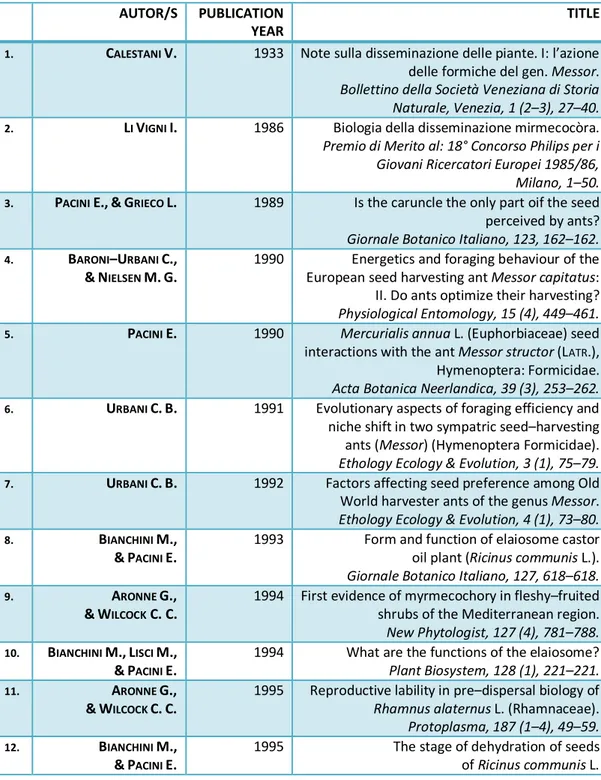INTERNATIONAL PH.D.COURSE IN:
PLANT HEALTH TECHNOLOGIES AND PROTECTION OF AGRO–ECOSYSTEMS –26THCYCLE
P
HILOSOPHIAE
D
OCTOR
T
HESIS
CANDIDATE FOR THE AWARD OF THE DEGREE
I
GNAZIO
L
I
V
IGNI
Interactions between ants and diaspores of
flowering plants (myrmecochory) in Sicily
(Southern Italy): an important ecosystem
function of the Mediterranean basin
–––––––––––––––––––––––––––––––––––––––––––––––––––––––––––––––––––––––––––––––––– ACADEMIC YEARS 2010–2014
COORDINATOR Prof. CARMELO RAPISARDA
(UNIVERSITY OF CATANIA) SUPERVISORS Prof. GAETANA MAZZEO
(ON THE COVER) Some ants carry a seed to their nest on the margins of the Ficuzza Wood (Western Sicily). It takes three Formica (Serviformica) cunicularia LATREILLE, 1798
(Formicinae: Formicini) workers [fresh weight (n = 50) 3.34–6.12 (4.97) mg; TL (n = 87) 4.13–6.72 (5.94) mm], to transport a seed of Ricinus communis L. (Euphorbiaceae) [fresh weight (n = 100) 328.62–463.75 (380.07) mg; TL (n = 100) 11.03–14.08 (13.14) mm]. Both species are natives of the Mediterranean basin, where they are very common, even in disturbed habitats. Scale bar in mm. (Original drawing © LI VIGNI from LI VIGNI &
Table of contents
––––––––––––––––––––––––––––––––––––––––––––––––––––––––––––––––––––––––––––––––––
“Believe me, you will find more lessons in the woods than in books. Trees and stones will teach you what you cannot learn from masters.” ST.BERNARD OF CLAIRVAUX (1090–1153)
Epistola, 106, 2. ––––––––––––––––––––––––––––––––––––––––––––––––––––––––––––––––––––––––––––––––––
PREFACE 5
CHAPTER 1 – Myrmecochory: an ecologically significant ant–plant interaction with worldwide distribution 9 CONTENTS 10 1. THE ANTS 11 2. THE FLOWERING PLANTS 14 3. SEED DISPERSAL 15 4. ELAIOSOMES 18
5. SEED DISPERSAL BY ANTS (MYRMECOCHORY) 18
REFERENCES 22
CHAPTER 2 –Myrmecochorous plants of Sicily (Southern Italy) 41
ABSTRACT 42
KEYWORDS 42
CONTENTS 43
1. INTRODUCTION 44
2. MATERIALS AND METHODS 45
2.2. STUDY AREAS 45
2.3. CLIMATIC ZONE 46
2.4. ECOLOGY 48
2.5. SPECIES SELECTION 50
2.6. SEM PHOTOS 50
3. RESULTS AND DISCUSSION 50
ACKNOWLEDGEMENTS 56
REFERENCES 56
CHAPTER 3 – Epigaeic myrmecofauna in a Mediterranean forest using a new integrated design of pitfall trap 83
ABSTRACT 84
KEYWORDS 84
CONTENTS 85
1. INTRODUCTION 86
1.1. HISTORY OF INVESTIGATION 87
2. MATERIALSANDMETHODS 90
2.1. STUDY AREA AND SITES 90
2.2. FDPT’S CONSTRUCTION BACKGROUND 91 CONSTRUCTION MATERIAL 91 SHAPE AND SIZE 92 CONSERVATION LIQUID 92 FUNNEL AND TALC 93 DOUBLE GLASS 94 SPILLWAYS 94
COVER AND FENCE 94
THE TRAP RIM 94
TRAP SET PLACEMENT 94
2.3. FDPT’S METHODOLOGY 95
2.4. FIELD SAMPLING PROTOCOL 95
2.5. SAMPLES PROCESSING AND ANTS IDENTIFICATION 96
2.6. DATA ANALYSIS 97 3. RESULTS 99 3.1. TRAPS EFFICIENCY 99 3.2. ANT SPECIES COLLECTED 100 4. CONCLUSION 103 ACKNOWLEDGEMENTS 104 REFERENCES 105
CHAPTER 4 – Biological aspects and myrmecochory of Corydalis densiflora C. PRESL
(Papaveraceae: Fumarioideae), endemic taxon of Southern Italy and Sicily 131
ABSTRACT 132
KEYWORDS 132
CONTENTS 133
1. INTRODUCTION 134
2. MATERIALS AND METHODS 136
2.1. STUDY SITE 136
2.2. STUDY SPECIES 137
2.3. FIELD EXPERIMENTS 139
2.4. STATISTICAL ANALYSIS 140
3. RESULTS AND DISCUSSIONS 141
3.1. STUDY SPECIES:CORYDALIS DENSIFLORA 141
DISTRIBUTION IN SICILY 141
TAXONOMY AND PLANT MORPHOLOGY 142
DIASPORE ANATOMY 143
SEED GERMINATION IN CONTROLLED CONDITIONS 145
3.2. STUDY SPECIES:ANT DISPERSERS 146
3.3. FIELD EXPERIMENTS 148
SEED DISPERSAL 148
ACKNOWLEDGEMENTS 150
REFERENCES 150
CONCLUSIONS AND FUTURE OUTLOOKS 169
GLOSSARY 174
REFERENCES 176
Preface
––––––––––––––––––––––––––––––––––––––––––––––––––––––––––––––––––––––––––––––––––
“After decades of studies on seed dispersal by animals, we are still ignorant about which seed–dispersing species are obligatory dispersers for the survival of many plants.” From “Why seed dispersers matter”, an interview with P. M. FORGET (2010) Chair of the 5thFrugivore and Seed Dispersal International Symposium.
http://news.mongabay.com/2010/0307–hance_forget.html (accessed 13 September 2014). ––––––––––––––––––––––––––––––––––––––––––––––––––––––––––––––––––––––––––––––––––
Since plants do not move from place to place, they have developed ways to make certain that their seeds are taken well away from them; this is called seed dispersal. Seed dispersal is important because if the seeds were to develop close to the parent plant, the young plants would not receive enough sunlight to grow. If plants are too close together they compete for light, water and minerals. It is much better if the seeds develop (i. e. germinate) in another area.
Seed dispersal has long been an object of fascination to biologists and the general public alike. Examples abound of structures that have clearly evolved to promote dispersal by wind, water or on the outside or inside of animals, but it is only recently that attention has turned to the question of just how well these structures work and what happens to the seeds of all those species (the majority) with no obvious adaptations for dispersal. Few things in seed ecology have changed more in recent years than our understanding of seed dispersal.
In the last decades the interest for plant–animal interactions increased dramatically and nowadays it is a firmly established discipline. The late development of this field was in part due to the historical progress of the knowledge on plants and animals in two separate lanes, only occasionally interacting with each other. Especially during the 80’s, we witnessed to an explosion in the number of publications dealing with a variety of thematic on plant–animal interactions and this large amount of information allowed the
development of many theories explaining ecological patterns and processes. Nowadays the study of plant–animal interactions encompasses various areas of knowledge (e. g. ecology, ethology, physiology, biochemistry) allowing a better comprehension of the phenomena under study.
The processes governing the evolution of plant–animal dispersal mutualisms have been the topic of important investigations. The observation that plants were generally dispersed by more than one animal species led authors to question the initial vision of pairwise tightly coevolved associations.
Myrmecochory (i. e. seed dispersal by ants) is a mutualistic interaction between ants and plants, where the elaiosome plays a critical role in ant attraction and subsequent seed removal. Over the World, thousands of species of herbs, shrubs, and trees are known to be principally ant–dispersed. In the myrmecochory rules, relationships, and bio– ecological characteristics surprisingly recur, albeit with local variations, in all biogeographic regions of the World. These analogies and these recurrences can be explained simply by the exceptional reappearance, in a multitude of plants and ants of various genera and species of similar ecological conditions that led to the phenomenon of convergent evolution in the plants.
Seed dispersal by ants although it is common in nature, is probably the least studied of the main seed dispersal syndromes. Biologists are just beginning to recognize the specialized mechanisms that make ants a major force in the spread of plants around the World. As the long list of known myrmecochores grows, biologists can expect to learn more about the importance of this seed–dispersal mechanism around the World. Further studies of the benefits of myrmecochory for plants and ants should also help to elucidate details of mutualistic relationships and their evolutionary consequences. Despite of the over 1,500 publications on myrmecochory and despite the large number of myrmecochores existing worldwide (possibly up to 23,000 species or 8.5% of all Angiospermae), there is still a tremendous lack of information.
Seed dispersal by ants is often studied empirically because it is a phenomenon difficult to observe in strictly natural conditions. The most effective method is to collect the seeds of a myrmecochorous plants, place them near the entrance of an ants nest, and wait that the workers will find them. This method involves the intervention of the observer and not a true natural observation.
In chapter 1, all these aspects are analyzed in relation to the myrmecochory.
The climate of a region will determine which plants will grow there, and which animals will inhabit it. The climate, also, indirectly controls the communities via changes in interspecific interactions. In the Mediterranean ecosystems of Southern Africa and Australia, the role of ants in the dispersal of seeds is well known and antagonistic interactions as well as myrmecochory occur. The high prevalence of seed dispersal by ants, compared to that by vertebrates, is viewed as evidence of adaptation to the soil nutrient deficiency typical of these environments. Instead, for a long time, ant dispersal has been considered unimportant in the Mediterranean basin and before 1994, no systematic study on ant–seed interaction had been undertaken. Only in the 1994 ARONNE &WILCOCK (see: First evidence of myrmecochory in fleshy–fruited shrubs of
the Mediterranean region. New Phytologist, 127 (4), 781–788) have realized a systematic study on the myrmecochory in the Mediterranean shrubland of Southern Italy (in the Nature Reserve at Castelvolturno, in the Bay of Naples). Since then, few other studies have been made in Italy, Spain, and France.
In chapter 2, wanting to fill this gap, I have undertaken a systematic study on the myrmecochory in an extended Mediterranean area of Southern Italy. I focused in my work on the seeds fate of supposedly myrmecochores, i. e. flowering plants whose sexual diaspores have elaiosomes, in forest ecosystems of European–Mediterranean region, where these herbs are quite numerous. The coupling of the fruiting season and the peak foraging period of ants suggests that ants will disperse a majority of the seeds away from the parent plant. This study has been realized in two different areas of Sicily that altogether span a land area ofabout 50,000 hectares of Mediterranean flora: the Oriented Nature Reserve Bosco della Ficuzza, Rocca Busambra, Bosco del Cappelliere, and Gorgo del Drago (Western Sicily) and the Madonie Regional Natural Park (North– Western Sicily). The research conducted highlighted that in the Mediterranean area myrmecochory is a fundamental ecological interaction. In the study areas the myrmecochorous species were surveyed and they account for approximately 8% of the total number of plant species (over fifteen hundred). Myrmecochorous plant species never identified before were reported.
At current state–of–the–art a pitfall trap specifically effective in capturing epigaeic ants does not exist. In chapter 3, for the purposes of monitoring the Formicidae I conceived a new design of trap for ants, in order to meet the needs of maximizing
capture of myrmecofauna reducing the presence of intruders, for filling a gap in the existing literature. The epigaeic myrmecofauna of the Ficuzza Wood reserve was collected with this protocol and twenty ant species have been identified.
In chapter 4, a complex study–type (cafeteria experiment, diaspore anatomy, seed germination in controlled conditions) conducted on a plant endemic to Sicily (Corydalis densiflora C.PRESL), for the first time as myrmecochores, is reported.
Since the topic of this Ph. D. thesis crosses different biological disciplines, it would have been impossible without the additional expertise of entomologists, myrmecologists, botanists, zoologists, and ecologists. I am thankful to C. RAPISARDA,G. MAZZEO, L.
ZAPPALÀ (Dipartimento di Gestione dei Sistemi Agroalimentari e Ambientali, Sezione
di Entomologia applicata, University of Catania, Italy), and B. MASSA (Dipartimento di
Scienze Agrarie e Forestali, Laboratorio di Zoologia applicata, University of Palermo, Italy) for their continuous support. G. DORIA, M. TAVANO, and R. POGGI (Museo
Civico di Storia Naturale DORIA of Genoa, Italy) for making it possible to view the
collections of the Italian ant species. F. RIGATO (Museo Civico di Storia Naturale of
Milan, Italy) to have confirmed the ant species identification. D. PIRAINA (Museo Civico
di Storia Naturale of Milan, Italy) for ant photography under a stereomicroscope. S. CAMBRIA (Banca di Germoplasma del Mediterraneo ONLUS of Palermo, Italy) for
assistance in the plant species determination. B. L. PATERNOSTRO, M. DELIA, A.
PIZZOLATO,andD.MAGGIORE (Banca di Germoplasma del Mediterraneo ONLUS of
Palermo, Italy) for their constructive criticisms on an earlier draft of this thesis and for assistance in field work. A. WESTRICH and Z. LIEBERMAN (California Academy of
Sciences, San Francisco, USA) for their helpful linguistic suggestions and corrections that improved the text.
Chapter 1
––––––––––––––––––––––––––––––––––––––––––––––––––––––––––––––––––––––––––––––––––
“– Everything wants to be everywhere – With this brief but significant phrase, the biologist Danish D. HILLENIUS (1927–1987), has characterized the irrepressible impulse with which all forms of life seek the smallest and most hidden corner of the Earth to preserve their species and to multiply. It is this imperious desire that is the basis of the competition, of natural selection, and at the end of evolution. – Everything wants to be everywhere – And everywhere results to be always another place.” BIJNSDORP R.(1993)
––––––––––––––––––––––––––––––––––––––––––––––––––––––––––––––––––––––––––––––––––
Myrmecochory: an ecologically
significant ant–plant interaction with
worldwide distribution
CONTENTS
1. THE ANTS
2. THE FLOWERING PLANTS
3. SEED DISPERSAL
4. THE ELAIOSOMES
5. SEED DISPERSAL BY ANTS (MYRMECOCHORY)
1. T
HE
A
NTS
Insecta is the most abundant class of the phylum Arthropoda. One million species have been described and represent 70% of all known animal species (i. e. insects + others invertebrates + chordates: n = 1.4 million). Annually 8,000–10,000 new species of insects are discovered and 5–30 million yet to be found are estimated (CARWARDINE,
2007; CHAPMAN,2009).
The ants are social insects classified in the suborder Apocrita GERSTAECKER, 1867 of
order Hymenoptera which contains 115,000 species (HYMENOPTERA ONLINE, 2014)
(estimate 300,000: CHAPMAN, 2009) and constitute a monophyletic group, the
Formicidae family, divided into 20 subfamilies (TABLE 1) and 470 genera, within the Vespoidea superfamily (TABLE 2). Since the inception of modern taxonomy 253 years ago, from Formica rufa rufa LINNEAUS, 1761 (LINNAEUS, 1761) to Mystrium eques
YOSHIMURA &FISHER, 2014 (YOSHIMURA &FISHER, 2014), almost 16,000 ant species
and subspecies have been described (ANTCAT/BOLTON, 2014). Estimates suggest that
the total number ranges between 25,000 and 30,000 species (LACHET AL., 2010), with
the majority of the species confined to the tropics (HÖLLDOBLER & WILSON,2009).
The head, alitrunk, and gaster are the three distinct body segments of the Formicidae. Ants are distinct in their morphology from other insects in having elbowed antennae, metapleural glands, and a strong constriction of their second abdominal segment (petiole). The third abdominal segment is often similarly constricted (postpetiole, characteristic of the largest subfamily Myrmicinae and of Pseudomyrmecinae, and most Ecitoninae). The presence of single–segment petiole or two–segment petiole is an easy way to visually classify major subfamilies of Formicidae. The elbowed antennae distinguish ants from other wingless wasps. Metapleural glands (situated in the metathorax) are secretory glands that are unique to ants. They are responsible for the production of an antibiotic fluid; this helps to prevent the growth of bacterial and fungal spores on the ants, and inside their nest. Ants are usually black, brown or reddish, and live in colonies with well–defined castes (typically a worker caste of sterile females and a reproductive caste of winged males and females). Virtually all ant keys are for workers only. Males and often queens can be radically different in appearance from workers. Males die shortly after mating and females tear off their wings after mating or just before entering a nesting site, and of course remain wingless for the rest of their lives of 9–10 weeks to 30 years, depending on the species. Ants are holometabolous,
with the pupa in a cocoon or not, as determined by subfamily, subgenus or even species. In some species, worker pupae are naked or facultatively naked, while sexual pupae are in a cocoon. Nest–founding queens typically rear the first brood of small (nanitic or minim) workers alone, either sealed in a nest cell and feeding off stored fat, and lysing wing musculature (claustrally) or occasionally (semiclaustrally) or regularly foraging for food while rearing the first brood, but almost never after the first workers emerge (BORROR ET AL.,1989; HÖLLDOBLER &WILSON,1990) (FIGURE 1 and 2).
Interspecific body length is extremely variable. According to BEATTIE (1985), this
difference is the same order of magnitude as that between a deer mouse and a mountain lion, a human and a blue whale or a sunflower and a spruce tree (FIGURE 3). A whole colony of Oceania Carebara atoma (EMERY, 1900) could live comfortably within the head
capsule of a soldier of Borneo Camponotus gigas (LATREILLE, 1802) (HÖLLDOBLER &
WILSON, 1994; MOFFETT, 2010). Besides the body size of the individual, colony size
(number of individuals) also varies greatly.
The smallest known colonies of ants in the World belong to Adelomyrmex biroi EMERY,
1897 of New Guinea and contain just 10 adult individuals (WILSON, 1959). One among
the largest polydomous “supercolonies”, constituting 45,000 nests which covered an area of 2.7 km2, is that of Formica yessensis W
HEELER, 1913 of Japan, with about 307
million of adults (HIGASHI &YAMAUCHI,1979;HIGASHI,1983).
Species richness encompasses a very wide range of morphological, physiological, and ecological diversity. Ants are among the most abundant terrestrial life forms (KAUTZ &
MOREAU, 2011); they are predominant in terms of density among all arthropods, despite
representing 1.6% of the total number of insect species. Ants often comprise 80% of the arthropods in tropical rain forests (DAVIDSON & PATRELL–KIM, 1996). For
example, on the Ivory Coast savanna (Western Africa) the density of ants is 7,000 colonies and 20 million individuals per hectare, with one species alone, Camponotus acvapimensis MAYR, 1862, with 2 million of individuals (LÉVIEUX, 1966, 1982).
The ants are successful not only in terms of sheer numbers, but in their geographical coverage of Earth as well. They have a cosmopolitan geographical distribution and occupy a wide range of ecological niches: they live from the Sahara desert to the heart of Australia, from the forests North of the Arctic Polar Circle to the tundra (HÖLLDOBLER &WILSON, 1994).
It has been estimated that the population of ants on Earth amounts from one to ten million billion individuals and hence ants and humans have equivalent biomass (HÖLLDOBLER &WILSON, 2009). Within the environments where they occur, they have
been estimated to contribute 15–25% of all the total terrestrial animal biomass, which well exceeds those of the vertebrates (SCHULTZ, 2000). All these features make them a
very important taxon among terrestrial invertebrates, with fundamental ecological functions. It is for these reasons that ants have been used as a focal taxon to indicate biodiversity of an ecosystem (e. g. UNDERWOOD & FISHER, 2006). From a single
leguminous tree in the Tambopata Reserve of Peru, 43 species of ants belonging to 26 genera have been recovered, about equal to the entire ant fauna of the British Isles (WILSON, 1987).
They perform important ecological roles as herbivores (the Neotropical leaf–cutting ants in their environments are also the main herbivores: CHERRETT,1982) and they are
major arthropod predators, and scavengers among invertebrates. Soil–nesting ants turn more soil than earthworms, thereby circulating large amounts of essential nutrients to the soil, favoring also the infiltration of water and the exchange of oxygen (FOLGARAIT,
1998). In addition, the Formicidae are a source of food for lizards, small predatory mammals, insectivorous birds, and arthropods including spiders, ant–lions, and beetles (COLLINGWOOD ET AL., 2011). One of the most important adaptations contributing to
the success of ants was the development of “eusociality” (sensu HÖLLDOBLER &
WILSON, 1994).
After a modest beginning in the Cretaceous, which took place in Africa 95 million years ago (MYA) (SCHMIDT ET AL., 2010), the Formicidae came to occupy key positions in
the majority of terrestrial ecosystems, establishing relations with thousands of species of arthropods (KISTNER, 1982), with unknown number of fungi and microorganisms
(MUELLER ET AL., 2001), and 470 species of myrmecophile plants belonging to 50
families (JOLIVET, 1998). In 20 species of plants belonging to several genera, pollination
by ants has been demonstrated, but the true number may be closer to one hundred (RICO–GRAY &OLIVEIRA, 2007). At least 11,500 species of myrmecochorous flowering
plants belonging to 77 families, and 334 genera have diaspores with elaiosomes, which serve as food reward, so that the ants enact dispersion (LENGYEL ET AL., 2010).
2. T
HE
F
LOWERING
P
LANTS
The division of Angiospermae LINDLEY, 1830 or Magnoliophyta CRONQUIST,TAKHT.
&ZIMMERM., 1966 is the most diverse group of advanced land plants. Angiospermae
are seed–producing plants like the Gymnospermae LINDLEY, 1830 and can be
distinguished from the Gymnospermae by a series of synapomorphies (i. e. derived characteristics). These characteristics include flowers, endosperm within the seeds, and the production of fruits that contain the seeds.
The Angiospermae are the “higher” more (= seed plants or Spermatophyta LINNAEUS,
1753) evolved plants of the plant kingdom. The Angiospermae experienced a tremendous radiation in all geographic regions during the Mid–Cretaceous (90 MYA) (RICO–GRAY & OLIVEIRA, 2007). The total number of flowering plant species is
estimated to be in the range of 270,000 to 400,000 (THORNE,2002;GOVAERTS,2003;
CHAPMAN, 2009). The Angiospermae are in a ratio of about twenty to one against
Pteridophyta LINNAEUS, 1753 (or seedless vascular plants, i. e. lycopods, selaginellas,
horsetails, and ferns) and Gimnospermae (i. e. substantially conifers), in practice the rest of terrestrial plants or vascular plants. The flowering proved to be an unusually effective means of reproduction, spreading (whatever its origin) to become the dominant form of land plant life (TABLE 5).
The seed develops from the ovule. All mature seeds contain an embryo and a protective covering called a seed coat (testa). In early development all Angiospermae seeds also contain an endosperm, but in many seeds the endosperm is completely absorbed by the developing embryo. The embryo and endosperm are products of fertilization while the seed coat develops from the integuments of the ovule. Each ovule inside an ovary develops into a seed when fertilized. The stalk of the ovule and of the subsequent seed is termed the funicle and may play a part in the dispersal of the seed from the mature ovary (the fruit). If the seed is detached from the funicle it will leave a scar, the hilum. The distal end of an ovule is enveloped by one or two layers of tissue, the integuments, which usually do not meet completely at the top leaving a hole, the micropyle, through which the pollen tube may find entry to the ovule at fertilization. As the ovule enlarges into a seed, one or both integuments develop into the seed coat. The micropyle may remain visible on the seed. Some ovules are bent over on the funicle (anatropous as opposed to orthotropous) and the micropyle in the seed is therefore next to the hilum, the funicle appearing as a ridge fused down the side of the seed and then known as the
raphe. The seed coat can be much elaborated and very hard (sclerotesta). If it develops with a soft layer it is termed a sarcotesta (FIGURE 4).
The function of the seed is to protect the embryo, to sense environmental conditions favorable to germination, to nourish the germinating seedling, and disperses the progeny to a new location. The seed coat contains a variety of adaptations related to protection and dispersal mechanisms; usually, it forms a dry layer that prevents destruction of the seed by dehydration or predation. It may contain waxes for water impermeability, mucilage to make seeds sticky, compounds resistant to digestion by animals, etc.
Fruit develops from organs of the flower and thus involve differentiation or re– differentiation of preexisting organs. Evolutionarily, floral organs represent modified leaves (carpels) and so the fruit is also a modified leaf. Fruits serve two functions: to protect the seeds during development and then to disperse the seeds following maturation. Most fruit develops from the ovary. In fact some schemes classify fruit derived from a single ovary as “true fruits” while “false fruits” are composed of tissues derived from flower parts other than the ovary or from more than one ovary. In true fruits the outside of the fruit is called the pericarp and develops from the ovary wall. The pericarp can be dry and papery, woody or fleshy. These pericarp differences reflect adaptations to different dispersal mechanisms. The fruit can contain a single seed or many seeds. The pericarp of some fruits is further differentiated into specialized layers called exocarp, meso– and endocarp (e. g. ESAU, 1977; FAHN, 1990; RAVEN ET AL.,
1999;RUDALL,2007; BERG,2008).
3. S
EED
D
ISPERSAL
The dispersal constitutes a determinant step in the biological cycle of most organisms (BOULAY ET AL.,2006). In the flowering plants, the completion of their biological cycle
goes through the dispersal of reproductive structures: the pollen for the cross– fertilization and the seeds for the colonization of new areas (HERRERA, 2002). Seed
dispersal is central to plant reproduction, population genetics, and ecology because it determines the movement of plant genes in space and in time. Even subtle changes in traits that influence seed dispersal can therefore have far–reaching consequences on a
multitude of other biological traits and, thus, dispersal mode is one of the most fundamental life history traits in plants (LENGYEL ET AL., 2010).
Seed dispersal has attracted scientists since long ago, i. e. DARWIN (1859), KERNER
(1896), SCHMIDT (1918), ULBRICH (1928), RIDLEY (1930), PIJL VAN DER (1982),
MÜLLER–SCHNEIDER (1983).
Seed dispersal has long been an object of fascination to biologists and the general public alike. Examples abound of structures that have clearly evolved to promote dispersal by wind, water or on the outside or inside of animals, but it is only recently that attention has turned to the question of just how well these structures work and what happens to the seeds of all those species (the majority) with no obvious adaptations for dispersal. Few things in seed ecology have changed more in recent years than our understanding of seed dispersal (FENNER &THOMPSON, 2005).
Seed dispersal is one of the central topics in modern biology, with implications for ecology, ethology, plant and animal biogeography, speciation and evolution (MURRAY,
1987).
Seed dispersal is an important function provided by the facilities of an ecosystem and it has an impact also on plant species richness, abundance, and successions of vegetation (EHRLÉN & ERIKSSON, 2000; TÜRKE, 2011). Seed dispersal links the sessile plants to
ecological processes operating at larger geographic scales such as long–distance dispersal, colonization, range expansion, isolation and speciation (BULLOCK &NATHAN,
2008).
Seed dispersal is also an ecological challenge for plants, that they frequently overcome using animal movement in exchange of food rewards (BOULAY ET AL., 2006). Seed
dispersal modes are usually classified into five broad types (syndromes): unaided (e. g. passive, ballistic), by wind (anemochory), by water (hydrochory), by vertebrates externally (e. g. on fur: exozoochory) or internally (passing through the gut: endozoochory), more specifically by insects (entomochory) and in particular by ants (myrmecochory) (PIJL VAN DER, 1982). Although it is recognized that these modes
differ dramatically in their benefits (and costs) to plants, the number of origins and global significance of different modes of seed dispersal remain poorly understood (PIJL VAN DER,1982;LENGYEL ET AL.,2010;VITTOZ &ENGLER, 2007).
Fruit is frequently a seed dispersal tool that attracts animals to eat or otherwise disturb it, incidentally scattering the seeds it contains. Seed dispersal by animals (zoochory) is a critical plant–animal mutualism that plays an important role in the gene flow, demography, distribution and evolution of plants (HOWE & SMALLWOOD, 1982; PIJL VAN DER, 1982; RICHARDSON ET AL., 2002). Theoretical developments considering
spatial variations of interactions suggest that even such diffuse mutualisms may be driven by coevolutionary processes (THOMPSON, 1994). Hence, plant–disperser
coadaptations likely vary with space and time depending on the species involved in the mutualism in conjunction with abiotic (e. g. climate) and biotic (e. g. presence of predators or parasites) constraints. The expected result is a geographic mosaic in which well–matched adaptations evolve locally and further extend to other populations while unfavorable associations tend to be eliminated (BOULAY ET AL.,2006).
The interactions between animals and plants are diverse and omnipresent in nature. These organisms have been evolving together for millions of years, with varying types and degrees of interaction between them. In some cases, plants and animals share an extremely specialized interaction, being dependent on each other and exhibiting peculiar morphological, ethological and physiological adaptations. However, the large majority of interactions between plants and animals are not specialized and are usually facultative (HERRERA, 2002).
In the last decades the interest for plant–animal interactions increased dramatically and nowadays it is a firmly established discipline. The late development of this field was in part due to the historical progress of the knowledge on plants and animals in two separate lanes, only occasionally interacting with each other. Especially during the 80’s, we witnessed to an explosion in the number of publications dealing with a variety of thematic on plant–animal interactions and this large amount of information allowed the development of many theories explaining ecological patterns and processes. Nowadays the study of plant–animal interactions encompasses various areas of knowledge (e. g. ecology, ethology, physiology, biochemistry) allowing a better comprehension of the phenomena under study (HERRERA &PELLMYR,2002).
The processes governing the evolution of plant–animal dispersal mutualisms have been the topic of important investigations. The observation that plants were generally dispersed by more than one animal species led authors to question the initial vision of pairwise tightly coevolved associations (HOWE,1984; BOULAY ET AL.,2006).
4. E
LAIOSOMES
The elaiosome, working as alimentary bounty urges ants to gather the diaspores (i. e. seeds or seeds and fruits together + elaiosome) and to scatter them about along their way unharmed soon after removing the elaiosome; this is partial carpophagy of the diaspore with consequent indirect seed dispersal by ants (LI VIGNI &MELATI, 1999).
These edible external appendages are shown in thousands of plant species worldwide (HANZAWA ET AL., 1988), they may vary, e. g. in their shape, coloration, size
(TAHTADZHJAN, 1985) and are different in their origin, but they all consist of
parenchymatous lipid–rich cells (KOMAR, 1978). These structures are found both in
seeds (e. g. Chelidonium majus L., Corydalis aurea WILLD., Viola odorata L.) or in seeds and
fruits together (e. g. Borago officinalis L., Lamium amplexicaule L., Pulmonaria officinalis L.) and appear in plants systematically far from each other, so that in these cases we can talk about convergent evolution in flowering plants (LI VIGNI &MELATI, 1999).
Generally the elaiosome is: a caruncle (or micropylar aril: elaiosome originating in the region of micropyle); a strophiole (or raphal aril: elaiosome originating along raphe– antiraphe) or an aril (or true aril: elaiosome originating on a funicle) (TAHTADZHJAN,
1985; GORB &GORB,2003) (FIGURE 5).
5. S
EED
D
ISPERSAL BY
A
NTS
(M
YRMECOCHORY
)
Myrmecochory, i. e. diaspore dispersal by ants, is a mutualistic interaction between ants and plants, where the elaiosome plays a critical role in ant attraction and subsequent seed removal. Over the World, thousands of species of herbs, shrubs, and trees are known to be principally ant–dispersed (BEATTIE &HUGHES, 2002). In all cases studied
to date, the primary function of elaiosomes is to attract ants and elicit the transport of the diaspore usually to the nest by the ants as destiny. In the nest, ants consume the elaiosome or, more often, feed it to their larvae (because provide various nutrients that are essential for insect reproduction and development). The intact seeds (i. e. still viable: LI VIGNI &PATERNOSTRO, 2005) are then abandoned in garbage piles in chambers in
the nest or outside the nest. Elaiosomes thus function as rewards for ants in much the same way as fruits or berries serve as rewards for vertebrate dispersers (BRESINSKY,
EDWARDS ET AL.,2006;FOKUHL ET AL.,2007;FISCHER ET AL.,2008).
In the myrmecochory rules, relationships, and bio–ecological characteristics surprisingly recur, albeit with local variations, in all biogeographic regions of the World. These analogies and these recurrences can be explained simply by the exceptional reappearance, in a multitude of plants and ants of various genera and species of similar ecological conditions that led to the phenomenon of convergent evolution in the plants (BRONSTEIN ET AL., 2006).
Myrmecochory was first studied in depth by SERNANDER, a botanist at the University of
Uppsala in Sweden. In 1906 he published a distinguished review on Central European myrmecochorous shrubs (he recorded approximately 120–150 species: MAYER ET AL.,
2000; WEISS, 1908). SERNANDER was the first to use the terms: diaspore, elaiosome, and
myrmecochorous (WEISS, 1908).
There are ant species that carry seeds to their nests with the purpose of preying those (granivorous species). These ants, named harvester ants, collect a large number of seeds to their nests and usually destroy almost all of them (e. g. DETRAIN & TASSE, 2000).
Several works have highlighted the impact of harvester ants as post–dispersal seed predators, and their role in shaping plant communities composition, and structure (BROWN & HUMAN, 1997; MACMAHON ET AL., 2000). Seed–harvesting ants,
ecologically significant seed predators which store in underground granaries, are dominant elements in terms of biomass, and/or colony numbers, in the desert, and drier grasslands in warm, temperate, and tropical regions around the World (HÖLLDOBLER &WILSON,1990). They are primarily species of the Myrmicinae genera Pheidole, Monornoriurn, Pogonornyvmex, and Messor, which span the full spectrum from generalist omnivores to specialist granivores (ANDERSEN,1991). Harvesting ants feed
on seeds, but compensate, at least in part, for the damage caused by this predation by serving as important agents of seed dispersal (HÖLLDOBLER &WILSON,1990). Usually,
the species are highly polymorphic, with the larger individuals possessing powerful mandibles capable of cracking open seeds. Seed fragments are fed to larvae, but probably many harvested seeds escape destruction either by being abandoned in stores or by germinating quickly within the ant nests. Thus, seed harvesting by ants, which could be viewed as exclusively detrimental, actually may carry some benefits to the plant through dispersal and provision of local nutrients to the seedling (GULLAN &
transport or seed stores are abandoned, we can define seed dispersal by harvester ants “myrmecochory sensu lato”.
Several ant species discard seeds or seeds and fruits together which are too hard, but which have an elaiosome. The dispersal by ants of elaiosome–seeds is defined “myrmecochory sensu stricto” (e. g. ULBRICH,1928;BARROSO ET AL., 2013; LIMA ET AL.,
2013).
Myrmecochory is a common syndrome (i. e. a complex of special morphological, anatomical, biochemical, and phenological adaptations of plants, especially of the herbs, that enhance ant attraction and thus increase the effectiveness of myrmecochory: GORB
&GORB,2003) especially in Southern Hemispheric shrublands of Southern Africa and
Australia, and in the temperate woodlands of Northern Hemisphere, e. g. central Europe, and Northern America deciduous forests where myrmecochores can represent up to 30–50% of herbaceous biomass (SERNANDER, 1906; HANDEL ET AL., 1981;
WOLFF & DEBUSSCHE, 1999; GORB & GORB, 2003; SEIFERT, 2007; TÜRKE ET AL.,
2010). Throughout East–Northern America temperate deciduous forests, the ants disperse up to 70% of understory plant species (CANNER, 2010) (FIGURE 7).
In general, a single ant species complex (e. g. Aphaenogaster rudis ENZMANN, 1947 in
East–Northern America temperate deciduous forests) disperses a majority of seeds. The coupling of the fruiting season and the peak foraging period of ants suggests that ants will disperse a majority of the seeds away from the parent plant (CANNER, 2010).
According to the studies ofDUNN ET AL.(2007) and BRADSHAWET AL.(2011):
a) Most origins of seed dispersal by ants are associated with transitions from passive dispersal (including both wind and gravity) to myrmecochory. Only a very few cases where myrmecochorous seeds evolved from vertebrate–dispersed fleshy fruits fruit have been observed –
b) Morphological features for myrmecochory have evolved at least twenty times within the monocots –
c) Origins of myrmecochory are not associated with the rise of forests during the Cretaceous or with subsequent transitions of plant lineages into closed canopy habitats, nor are they contemporaneous with the origins of fleshy fruits. Instead, the origins of myrmecochory are closely associated with the rise in relative abundance of ants
(proportion of all individual insects in fossils) towards the end of the Eocene and more recently. The highest observed rate of origination of ant dispersal occurred substantially later (essentially the present) than that for fleshy fruits –
d) Elaiosomes evolved in response to changes in ant communities. An alternative to the hypothesis that ant communities have driven patterns of origination of elaiosomes is that changes in forest structure and climate have played a more important role. More specifically, it has been hypothesized that in closed canopy shaded habitats, dispersal by animals, including dispersal of seeds by ants, is more likely to evolve than in open canopy habitats due to the relative absence of wind.
Elaiosomes have independently evolved at least 100–150 times in flowering plants and their presence is estimated in up to 23,000 or 8.5% of all species of flowering plants (n = 270,000); in this way the elaiosomes are a dramatic example of convergent evolution in flowering plants (LENGYEL ET AL., 2010). Myrmecochory provides one of the best
examples to date for convergent evolution in general and for the repeated evolution of plant–animal mutualisms more specifically.
The families containing myrmecochorous genera are represented in all major lineages in the angiosperm phylogeny. Although myrmecochory is present in several families that diverged early (100 MYA) in angiosperm phylogeny, most families in which myrmecochory is found originated at or after 70–80 MYA (these time periods do not necessarily represent the dates of the evolutionary transitions to myrmecochory) (LENGYEL ET AL., 2010). LENGYEL ET AL. (2010) increase the number of
myrmecochorous species from 3,000 (BEATTIE,1985),and 4,000 (LI VIGNI &MELATI,
1999) to 11,500, indicating that myrmecochorous plants are a globally significant portion of plant diversity.
The ants involved in myrmecochory are carnivorous or omnivorous species that generally prey upon terrestrial invertebrates (GÓMEZ &ESPADALER,1995). These ants
are attracted by the elaiosomes due to their overall chemical affinities with ant prey and also by sharing the same chemical cues that elicit removal behaviour in ants (e. g. HUGHES ET AL., 1994). Most elaiosomes are particularly rich in lipids and evidence
suggests that fatty acids are involved in ant attraction. Oleic acid is abundant in the lipid fractions of the elaiosomes of many species. This fatty acid, which is responsible for corpse–carrying behavior in some ants, probably induces ants to pick up diaspores (LANZA ET AL., 1992).
The distance that the seed is moved depends on the distance of the source plant from the nest, and on the densities of food plants, and nests within habitat (COUSENS ET AL.,
2008). This distance varies with both ant species and environment (ANDERSEN, 1988;
ANDERSEN & MORRISON, 1998). In a review of the World literature, GÓMEZ &
ESPADALER (1998) found that the mean ant–dispersal distance was 0.96 m, with a range
from 1 cm to 77 m. The ants scatter the diaspores a short distance away. Studies on the distribution of existing flora have demonstrated the remarkable productiveness of small repeated displacements of seeds. On the other hand, the review of cases of transference over large distances (due to water or air streams or migratory animals), has led to the affirmation that the effectiveness of this is all but illusory. There would, for example, be problems of acclimatization, contending with the pre–existing vegetation. It seems that dispersal over a limited distance, which assures a gradual diffusion, has been the course followed by the majority of plants in carpeting the Earth’s surface, rather than transportation over large distances, which presents serious difficulties concerning environmental conditions. Dispersal over a short distance, therefore, in small stages, i. e. propinquus, without doubt prevails over longinquus dispersal, i. e. over an extensive area (CAPPELLETTI ET AL., 1935).
The larger ant species disperse seeds further than do smaller ants. The mean and maximum distances that ants transported seeds increase with ant body length. The directly proportional relationship between the size of ants in terms of length and width of the body and the distance of dispersed seeds has been only recently recognized (e. g. NESS ET AL.,2004) (FIGURE 8).
REFERENCES
1. ANDERSEN A.N. (1988) Dispersal distance as a benefit of myrmecochory. Oecologia, 75
(4), 507–511.
2. ANDERSEN A. N.(1991) Seed harvesting by ants in Australia. In: HUXLEY C. R.,& CUTLER D.F. (Editors). Ant–plant interactions. Oxford University Press, Oxford, 493–503. 3. ANDERSEN A. N., & MORRISON S. C. (1998) Myrmecochory in Australia’s seasonal
tropics: effects of disturbance on distance dispersal. Australian Journal of Ecology, 23 (5),
483–491.
http://antcat.org/ (accessed 17 September 2014).
5. BARROSO Á., AMOR F., CERDÁ X., & BOULAY R. R. (2013) Dispersal of non– myrmecochorous plants by a “keystone disperser” ant in a Mediterranean habitat reveals asymmetric interdependence. Insectes Sociaux, 60 (1), 75–86.
6. BEATTIE A. J. (1985) The evolutionary ecology of ant–plant mutualisms. Cambridge University Press, Cambridge, 1–182.
7. BEATTIE A., & HUGHES L. (2002) Ant–plant interactions. In: HERRERA C. M., & PELLMYR O.(Editors). Plant animal interactions. Blackwell Science, Oxford, 221–235. 8. BELL A. D. (1991) Plant form – An illustrated guide to flowering plant morphology.
Oxford University Press, Oxford, 1–341.
9. BERG L. R. (2008) Introductory botany – Plants, people, and the environment (2nd
edition). THOMSON BROOKS/COLE, Belmont, 1–622.
10. BERG–BINDER M. C. (2011) Consequences of interaction between the native ant community and an invasive plant (Euphorbia esula). Doctoral dissertation, University of Illinois
at Urbana–Champaign, 1–112.
11. BIJNSDORP R. (1993) Il Mare – Ricerca, scoperta, analisi, ecologia e biologia marine.
Mursia, Milano, 1–150.
12. BOLTON B. (1994) Identification guide to the ant genera of the world. Harvard University
Press, Cambridge, 1–222.
13. BORROR D. J.,TRIPLEHORN C.A., & JOHNSON N. F.(1989) An Introduction to the study of insects (6th edition). Saunders College Publishing, Philadelphia, 1–875.
14. BOULAY R., COLL–TOLEDANO J., & CERDÁ X. (2006) Geographic variations in
Helleborus foetidus elaiosome lipid composition: implications for dispersal by ants. Chemoecology, 16 (1), 1–7.
15. BRADSHAW S.D.,DIXON K.W.,HOPPER S.D.,LAMBERS H.,&TURNER S. R. (2011) Little evidence for fire–adapted plant traits in Mediterranean climate regions. Trends in
Plant Science, 16 (2), 69–76.
16. BRESINSKY A.(1963) Bau, entwicklungsgeschichte und inhaltsstoffe der elaiosomen – Studien zur myrmekochoren verbreitung von samen und früchten. Bibliotheca Botanica,
126, 1–54.
17. BREW C. R., O’DOWD D. J.,& RAE I. D. (1989) Seed dispersal by ants: behaviour– releasing compounds in elaiosomes. Oecologia, 80 (4), 490–497.
18. BRONSTEIN J. L., ALARCÓN R., & GEBER M. (2006) The evolution of plant–insect mutualisms. New Phytologist, 172 (3), 412–428.
19. BROWN M. J., & HUMAN K. G. (1997) Effects of harvester ants on plant species distribution and abundance in serpentine grassland. Oecologia, 112 (2), 237–243.
20. BULLOCK J. M., & NATHAN R. (2008) Plant dispersal across multiple scales: linking models and reality. Journal of Ecology, 96 (4), 567–568.
21. CANNER J. (2010) The population ecology of ant–dispersed plants in space and time. Doctoral dissertation, North Carolina State University, Raleigh, 1–98.
22. CAPPELLETTI C.,GOLA G.,&NEGRI G. (1935) Trattato di Botanica. Unione Tipografica
– Editrice Torinese (UTET), Torino, 799–803.
23. CARWARDINE M. (2007) Animal records. Natural History Museum, London, 1–256. 24. CHAPMAN A. D. (2009) Numbers of living species in Australia and the World (2nd
edition). Australian Biological Resources Study (ABRS), Canberra, 1–79.
25. CHERRETT J.M. (1982) The economic importance of leaf–cutting ants. In: BREED M. D.,MICHENER C.D.,&EVANS H. E. (Editors). The biology of social insects. Westview
Press, Boulder, 114–118.
26. COLLINGWOOD C. A. (1979) The Formicidae (Hymenoptera) of Fennoscandia and Denmark. Fauna Entomologica Scandinavica, 8, 1–174.
27. COLLINGWOOD C. A.,AGOSTI D.,SHARAF M. R.,&HARTEN VAN A. (2011) Order Hymenoptera, family Formicidae. Arthropod Fauna of the UAE, 4, 405–474.
28. COUSENS R., DYTHAM C., & LAW R. (2008) Dispersal in plants – A population perspective. Oxford University Press, Oxford, 1–221.
29. DARWIN C. R. (1859) On the origin of species by means of natural selection, or the preservation of favoured races in the struggle for life (1th edition). MURRAY J., London,
1–502.
30. DAVIDSON D.W.,&PATRELL–KIM L. (1996) Tropical ants – Why so abundant? In: GIBSON A. C. (Editor). Neotropical biodiversity and conservation. Mildred E. M.
Botanical Garden, University of California, Los Angeles, 127–140.
31. DETRAIN C.,& TASSE O. (2000) Seed drops and caches by the harvester ant Messor
barbarus: do they contribute to seed dispersal in Mediterranean grasslands? Naturwissenschaften, 87 (8), 373–376.
32. DUNN R.R.,GOVE A.D.,BARRACLOUGH T.G.,GIVNISH T.J.,&MAJER J.D. (2007) Convergent evolution of an ant–plant mutualism across plant families, continents, and time. Evolutionary Ecology Research, 9 (8), 1349–1362.
33. EDWARDS W.,DUNLOP M.,&RODGERSON L. (2006) The evolution of rewards: seed dispersal, seed size and elaiosome size. Journal of Ecology, 94 (3), 687–694.
34. EHRLÉN J.,&ERIKSSON O. (2000) Dispersal limitation and patch occupancy in forest herbs. Ecology, 81(6), 1667–1674.
35. ESAU K. (1977) Anatomy of seed plants (2nd edition). John Wiley & Sons, New York, 1–
550.
36. FAHN A. (1990) Plant Anatomy (4th edition). Pergamon Press, Oxford, 1–611.
37. FENNER M.,& THOMPSON K.(2005) The ecology of seeds. Cambridge University Press,
Cambridge, 1–260.
38. FINZI B.(1929)Le formiche italiane del genere Messor. Bollettino della Società Entomologica Italiana, Genova, 61, 75–94.
39. FISCHER R.C.,ÖLZANT S.M.,WANEK W.,&MAYER V.(2005) The fate of Corydalis cava elaiosomes within an ant colony of Myrmica rubra: elaiosomes are preferentially fed
to larvae. Insectes Sociaux, 52 (1), 55–62.
40. FISCHER R.C.,RICHTER A.,HADACEK F.,&MAYER V. (2008) Chemical differences between seeds and elaiosomes indicate an adaptation to nutritional needs of ants.
Oecologia, 155 (3), 539–547.
41. FOKUHL G.,HEINZE J.,&POSCHLOD P. (2007) Colony growth in Myrmica rubra with supplementation of myrmecochorous seeds. Ecological research, 22 (5), 845–847.
42. FOLGARAIT P.J. (1998) Ant biodiversity and its relationship to ecosystem functioning: a review. Biodiversity and Conservation, 7 (9), 1221–1244.
43. GÓMEZ C., & ESPADALER X. (1995) Biogeografia dels gèneres de formigues dispersants de llavors. Sessió Conjunta d’Entomologia ICHN–SCL, 9, 143–150.
44. GÓMEZ C., & ESPADALER X. (1998) Myrmecochorous dispersal distances: a World survey. Journal of Biogeography, 25 (3), 573–580.
45. GORB E.,&GORB S.(2003) Seed dispersal by ants in a deciduous forest ecosystem – Mechanisms, strategies, adaptations. Kluwer academic Publishers, Dordrecht, 1–225.
46. GOVAERTS R. (2003) How many species of seed plants are there? A response. Taxon, 52 (3), 583–584.
47. GULLAN P.J.,&CRANSTON P. S. (2009) The insects – An outline of entomology (3rd
edition). Blackwell Publishing Ltd., Oxford, 1–529.
48. HANDEL S.N.,FISCH S.B.,&SCHATZ G.E. (1981) Ants disperse a majority of herbs in a mesic forest community in New–York State. Bulletin of the Torrey Botanical Club, 108,
430–437.
49. HANZAWA F. M., BEATTIE A. J., & CULVER D. C. (1988) Directed dispersal: demographic analysis of an ant–seed mutualism. The American Naturalist, 131 (1), 1–13.
50. HERRERA C. M. (2002) Seed dispersal by vertebrates. In: HERRERA C.M.,&PELLMYR O. (Editors) Plant–animal interactions – An evolutionary approach. Blackwell Publishing,
Oxford, 185–208.
51. HERRERA C. M., & PELLMYR O. (Editors) (2002) Plant–animal interactions – An evolutionary approach. Blackwell Science, Oxford, 1–487.
52. HIGASHI S. (1983) Polygyny and nuptial flight of Formica (Formica) yessensis FOREL at Ishikari coast, Hokkaido, Japan. Insectes Sociaux, 30 (3), 287–297.
53. HIGASHI S.,&YAMAUCHI K.(1979) Influence of a supercolonial ant Formica (Formica) yessensis FOREL on the distribution of other ants in Ishikari Coast. Japanese Journal of
Ecology 29 (3), 257–264.
54. HÖLLDOBLER B., &WILSON E.O.(1990) The ants. Belknap Press of Harvard University
Press, Cambridge, 1–732.
55. HÖLLDOBLER B.,&WILSON E.O.(1994) Journey to the ants. Belknap Press of Harvard University Press, Cambridge, 1–228.
56. HÖLLDOBLER B.,&WILSON E. O. (2009) The superorganism – The beauty, elegance, and strangeness of insect societies. NORTON W. W. & Company Incorporated, New York, 1–522.
57. HOWE H.F. (1984) Constraints in the evolution of mutualisms. The American Naturalist,
123 (6), 764–777.
58. HOWE H.F.,&SMALLWOOD J. (1982) Ecology of seed dispersal. Annual review of ecology
and systematics, 13 (1), 201–228.
59. HUGHES L.,WESTOBY M. T., & JURADO E. (1994) Convergence of elaiosomes and insect prey: evidence from ant foraging behaviour and fatty acid composition. Functional
Ecology, 8 (3), 358–365.
60. HYMENOPTERA ONLINE (HOL)/VARIOUS CONTRIBUTORS (2014)
http://hol.osu.edu/updates.html (accessed 7 September 2014).
61. INTEGRATED TAXONOMIC INFORMATION SYSTEM (ITIS) (2014).
http://www.itis.gov/servlet/SingleRpt/SingleRpt?search_topic=TSN&search_value=587871 (accessed 28 September 2014).
62. JOLIVET P. (1998) Interrelationship between insects and plants. CRC Press, Boca Raton,
1–309.
63. KAUTZ S.,&MOREAU C.S.(2011) Creating encyclopedia of life’s species pages for ants (Hymenoptera: Formicidae): what we have done and what remains to be done.
64. KERNER VON MARILAUN A. (1896) The natural history of plants. 1–2, H. Holt, New York,
65. KISTNER D.H.(1982) The social insects’ bestiary. In: HERMAN H. R. (Editor). Social insects. Academic Press, New York, 3, 1–244.
66. KOMAR G. A.(1978) Arils and aril–like structures in some representatives of Liliales. Botanicheskii Zhurnal, 63 (7), 935–955.
67. LACH L.,PARR C.L.,& ABBOTT K.L. (Editors) (2010) Ant ecology. Oxford University
Press, Oxford, 1–402.
68. LANZA J.,SCHMITT M.A.,&AWAD A. B. (1992) Comparative chemistry of elaiosomes of three species of Trillium. Journal of chemical ecology, 18 (2), 209–221.
69. LENGYEL S., GOVE A. D., LATIMER A. M., MAJER J. D., & DUNN R. R. (2010) Convergent evolution of seed dispersal by ants, and phylogeny and biogeography in flowering plants: a global survey. Perspectives in Plant Ecology, Evolution and Systematics, 12
(1), 43–55.
70. LÉVIEUX J. (1966) Traits généraux du peuplement en fourmis terricoles d’une savane de Côte d’Ivoire. Comptes Rendus de l’Académie Des Sciences, Paris, D, 262 (14), 1583–1585. 71. LÉVIEUX J. (1982) A comparison of the ground dwelling ant populations between a
Guinea savanna and evergreen rain forest of the Ivory Coast. In: BREED M. D., MICHENER C. D., & EVANS H. E. (Editors). The biology of social insects. Westview Press, Boulder, 48–53.
72. LI VIGNI I.,&MELATI M.R.(1999) Examples of seed dispersal by entomochory. Acta Botanica Gallica, 146 (2), 145–156.
73. LI VIGNI I., & PATERNOSTRO B. (2005) La dispersione dei semi da parte delle formiche negli ecosistemi mediterranei erbacei ed arbustivi della Sicilia (Italia).
Informatore Botanico Italiano, 37 (1A), 222–223.
74. LIMA M.H.,OLIVEIRA E.G.,&SILVEIRA F.A.(2013) Interactions between ants and Non–myrmecochorous fruits in Miconia (Melastomataceae) in a Neotropical Savanna.
Biotropica, 45 (2), 217–223.
75. LINNAEUS C. (1761) Fauna suecica sistens animalia Sueciae regni – Mammalia, Aves, Amphibia, Pisces, Insecta, Vermes. Editio altera, auctior, Stockholmiae, 1–626.
76. MACMAHON J. A., MULL J. F., & CRIST T. O. (2000) Harvester ants (Pogonomyrmex spp.): their community and ecosystem influences. Annual Review of Ecology and Systematics,
31 (1), 265–291.
77. MAYER V., ÖLZANT S., KRÜCKL B., & MANHART M. (2000) Myrmecochory in European plants. Linzer Biologische Beiträge, 32 (2), 677–678.
78. MITROIU M.D.,RADCHENKO A.,&NOYES J. (2014) Formicidae. In: Fauna Europaea version 2.6. http://www.faunaeur.org (accessed 30 September 2014).
79. MOFFETT M. W. (2010) Adventures among ants – A global safari with a cast of trillions. University of California Press, Berkeley, 1–288.
80. MORA C.,TITTENSOR D.P.,ADL S.,SIMPSON A.G.B.,&WORM B.(2011) How many species are there on Earth and in the ocean? PLoS biology, 9 (8), e1001127. DOI:
10.1371/journal.pbio.1001127.
81. MUELLER U. G.,SCHULTZ T. R.,CURRIE C. R.,ADAMS R. M. M., & MALLOCH D. (2001) The origin of the attine ant–fungus mutualism. Quarterly Review of Biology, 76, 169–
197.
82. MÜLLER–SCHNEIDER P. (1983) Verbreitungsbiologie (Diasporologie) der blütenpflanzen. Veröffentlichungen des Geobotanischen Institutes Stiftung der ETH, Stiftung
Rübel, Zürich, 61, 1–226.
83. MURRAY D. R. (Editor) (1987) Seed dispersal. Academic Press, Sydney, 1–322.
84. NESS J.H.,BRONSTEIN J.L.,ANDERSEN A.N.,&HOLLAND J.N.(2004) Ant body size predicts dispersal distance of ant–adapted seeds: implications of small–ant invasions.
Ecology, 85 (5), 1244–1250.
85. PIJL VAN DER L. (1982) Principles of dispersal in higher plants. Springer–Verlag, Berlin,
1–214.
86. PRESTY J. (2014) Studies on taxonomy of Pheidole WESTWOOD – A major genus of subfamily Myrmicinae (Formicidae – Hymenoptera) of Kerala. Doctoral dissertation,
Mahatma Gandhi University, Kottayam, Kerala, 1–274.
87. RAVEN P. H., RAY F. E.,& EICHHORN S. E. (1999) Biology of plants (6th edition).
FREEMAN W. H. & Company/Wort Publishers, New York, 1–944.
88. RICHARDSON B.A.,BRUNSFELD S.J.,&KLOPFENSTEIN N.B. (2002) DNA from bird– dispersed seed and wind– disseminated pollen provides insights into postglacial colonization and population genetic structure of whitebark pine (Pinus albicaulis).
Molecular Ecology, 11 (2), 215–227.
89. RICO–GRAY V., & OLIVEIRA S. (2007) The ecology and evolution of ant–plant interactions. The University of Chicago press, Chicago, 1–321.
90. RIDLEY H. N. (1930) The dispersal of plants throughout the World. REEVE L. & Co., Ashford, 1–744.
91. RUDALL P. J. (2007) Anatomy of flowering plants – An introduction to structure and development. Cambridge University Press, Cambridge, 1–145.
92. SALEM M. Z.,&HOLE F.D.(1968) Ant (Formica exsectoides) pedoturbation in a forest soil. Soil Science Society of America Journal, 32 (4), 563–567.
93. SCHMIDT A. R., PERRICHOT V., SVOJTKA M., ANDERSON K. B., BELETE K. H., BUSSERT R.,DÖRFELT H.,JANCKE S.,MOHR B.,MOHRMANN E.,NASCIMBENE P.C., NEL A.,NEL P.,RAGAZZI E.,ROGHI G.,SAUPE E.E.,SCHMIDT K.,SCHNEIDER H., SELDEN P.A.,&VÁVRA N.(2010) Cretaceous African life captured in amber. Proceedings
of the National Academy of Sciences of the United States of America, 107 (16), 7329–7334.
94. SCHMIDT W. (1918) Die Verbreitung von samen und blütenstaub durch die luftbewegung. Österreichische Botanische Zeitschrift, 67, 313–328.
95. SCHULTZ T.R. (2000) In search of ant ancestors. Proceedings of the National Academy of Sciences, 97 (26), 14028–14029.
96. SEIFERT B. (1996) Ameisen beobachten, bestimmen. Naturbuch Verlag, Augsburg, 1–351. 97. SEIFERT B. (2007) Die Ameisen Mittel– und Nordeuropas. Lutra Verlags– und
Vertriebsgesellschaft, Görlitz, 1–368.
98. SERNANDER R. (1906) Entwurf einer monographie der Europäischen myrmekochoren. Kunglica Svenska Vetenskapsakademiens Handlingar, 41, 1–410.
99. SMITH M. R. (1965) House–infesting ants of the Eastern United States – Their recognition, biology, and economic importance. Technical Bulletin, Agricultural Research
Services United States Department of Agriculture, Washington, 1326, 1–105.
100. TAHTADZHJAN A. L. (Editor) (1985) Comparative anatomy of seeds – Monocotyledones. Nauka, Leningrad, 1, 1–317.
101. THOMPSON J. N. (1994) The coevolutionary process. University of Chicago Press, Chicago,
1–387.
102. THORNE R.F. (2002) How many species of seed plants are there? Taxon, 51 (3), 511– 522.
103. TÜRKE M. (2011). Complicating a complex ecosystem function: the controversial role of Gastropods in a myremcochorous seed dispersal mutualism. Doctoral dissertation,
Friedrich–Schiller–Universität Jena, Jena, 1–112.
104. TÜRKE M.,HEINZE E.,ANDREAS K.,SVENDSEN S.M.,GOSSNER M.M.,&WEISSER W. W. (2010) Seed consumption and dispersal of ant–dispersed plants by slugs.
Oecologia, 163 (3), 681–693.
105. ULBRICH E. (1928) Biologie der früchte und samen (Karpobiologie). Springer–Verlag,
Berlin, 1–230.
monitoring: if, when, and how. Biological conservation, 132 (2), 166–182.
107. VITTOZ P.,&ENGLER R.(2007)Seed dispersal distances: a typology based on dispersal modes and plant traits. Botanica Helvetica, 117 (2), 109–124.
108. WEISS F. E. (1908) The dispersal of fruits and seeds by ants. New Phytologist, 7 (1), 23–
28.
109. WILSON E. O. (1959) Some ecological characteristics of ants in New Guinea rain forests. Ecology, 40 (3), 437–447.
110. WILSON E. O. (1987) The arboreal ant fauna of Peruvian Amazon forests: a first assessment. Biotropica, 19 (3), 245–251.
111. WOLFF A.,& DEBUSSCHE M. (1999) Ants as seed dispersers in a Mediterranean old– field succession. Oikos, 84, 443–452.
112. YOSHIMURA M., &FISHER B. L. (2014) A revision of the ant genus Mystrium in the Malagasy region with description of six new species and remarks on Amblyopone and
TABLE 1 – EXTANT AND EXTINCT SUBFAMILIES OF FORMICIDAE (ACCORDING TO
BOLTON, 2014). The number of taxonomic entities of the Formicidae family is
continually subject to adjustments. The following numbers are updated at September 17, 2014 and are taken from ANTCAT/BOLTON. Extant: 16 subfamilies, 39 tribes, 324
genera, 12,984 species, 2,092 subspecies. Fossil: 4 subfamilies, 8 tribes, 146 genera, 688 species, 2 subspecies.
EUROPEAN FAMILIES WORLD EXTANT FOSSIL
1. Agroecomyrmecinae 17. †Armaniinae 2. Amblyoponinae 18. †Brownimeciinae 1. ► 3. Aneuretinae 19. †Formiciinae 2. ► 4. Dolichoderinae 20. †Sphecomyrminae 3. ► 5. Dorylinae 6. Ectatomminae 4. ► 7. Formicinae 8. Heteroponerinae 5. ► 9. Leptanillinae 10. Martialinae 6. ► 11. Myrmeciinae 12. Myrmicinae 13. Paraponerinae 7. ► 14. Ponerinae 15. Proceratiinae 16. Pseudomyrmecinae
TABLE 2 – TAXONOMIC HIERARCHY OF FORMICIDAE (ACCORDING TO INTEGRATED
TAXONOMIC INFORMATION SYSTEM,2014 ANDMITROIU ET AL.,2014). Ants are classified in
a single family (Formicidae) in the Hymenoptera order. They are closely related to wasps and bees. LATREILLE (1809) erected the name Formicariae based on the type
genus Formica. STEPHANS (1829) first spelled Formicidae. MAYR (1865) provided the
name Formicinae as subfamily of Formicidae, while HEER (1867) emended the name
Formicaria. ASHMEAD (1905) placed Formicidae under the Formicoidea superfamily.
BROTHERS (1975) later on the Formicidae family was transferred to Vespoidea
superfamily (PRESTY, 2014 and reference cited therein).
TAXONOMIC HIERARCHY – 1. Kingdom Animalia –– 2. Subkingdom Bilateria ––– 3. Infrakingdom Protostomia –––– 4. Superphylum Ecdysozoa ––––– 5. Phylum Arthropoda –––––– 6. Subphylum Hexapoda ––––––– 7. Class Insecta –––––––– 8. Subclass Pterygota ––––––––– 9. Infraclass Neoptera –––––––––– 10. Superorder Holometabola ––––––––––– 11. Order Hymenoptera –––––––––––– 12. Suborder Apocrita ––––––––––––– 13. Infraorder Aculeata –––––––––––––– 14. Superfamily Vespoidea ––––––––––––––– 15. Family Formicidae –––––––––––––––– 16. Subfamily Formicinae ––––––––––––––––– 17. Tribe Formicini
–––––––––––––––––– 18. Genus Formica LINNAEUS, 1758 ––––––––––––––––––– 19. Subgenus Formica LINNAEUS, 1758
–––––––––––––––––––– 20. Species Formica (Formica) rufa LINNAEUS, 1761 ––––––––––––––––––––– 21. Subspecies Formica (Formica) rufa rufa LINNAEUS, 1761
